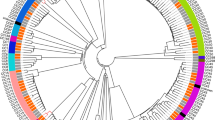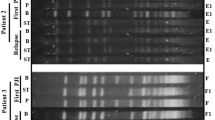Abstract
The objective of the study was to determine if a clonal complex (CC) of Staphylococcus aureus or certain virulence and adhesion factors were associated with infections of bones and prosthetic implants. One hundred and nineteen isolates were characterised using microarrays. There was no evidence for a single virulence factor or CC being causative for bone and implant infections. Isolates belonged to 20 different CCs, with CC8 (19.33%), CC45 (17.65%) and CC30 (12.61%) being dominant. Population structure and the relative abundances of virulence genes was similar to previously described isolates from healthy carriers. Differences to carrier isolates included a higher proportion of CC45, a lower proportion of CC15, as well as a higher abundance of sak (staphylokinase) among patient isolates. For 23 patients with infections of total knee or hip prosthetics, it was possible to simultaneously obtain nasal swabs. Fifteen (65.2%) carried S. aureus in their anterior nares. In nine of them (39.1%), isolates from the infection site were identical to carriage isolates. This suggests an elevated risk of infection for S. aureus carriers and the possibility of endogenous infection in a high proportion of them. Therefore, the pre-operative screening and eradication of S. aureus in patients receiving total joint prosthetics should be considered.
Similar content being viewed by others
References
Sourek J, Výmola F, Trojanová M, Zelenková L, Matĕjovska V, Bergdoll MS (1979) Enterotoxin production by Staphylococcus aureus strains isolated from cases of chronic osteomyelitis. J Clin Microbiol 9:266
Cunningham R, Cockayne A, Humphreys H (1996) Clinical and molecular aspects of the pathogenesis of Staphylococcus aureus bone and joint infections. J Med Microbiol 44:157
Dohin B, Gillet Y, Kohler R, Lina G, Vandenesch F, Vanhems P, Floret D, Etienne J (2007) Pediatric bone and joint infections caused by Panton–Valentine leukocidin-positive Staphylococcus aureus. Pediatr Infect Dis J 26:1042
Clarke SR, Foster SJ (2006) Surface adhesins of Staphylococcus aureus. Adv Microb Physiol 51:187
Dinges MM, Orwin PM, Schlievert PM (2000) Exotoxins of Staphylococcus aureus. Clin Microbiol Rev 13:16
Kaneko J, Kamio Y (2004) Bacterial two-component and hetero-heptameric pore-forming cytolytic toxins: structures, pore-forming mechanism, and organization of the genes. Biosci Biotechnol Biochem 68:981
Brady RA, Leid JG, Calhoun JH, Costerton JW, Shirtliff ME (2008) Osteomyelitis and the role of biofilms in chronic infection. FEMS Immunol Med Microbiol 52:13
Swingle EL (1935) Studies on small colony variants of Staphylococcus aureus. J Bacteriol 29:467
Proctor RA, Balwit JM, Vesga O (1994) Variant subpopulations of Staphylococcus aureus as cause of persistent and recurrent infections. Infect Agents Dis 3:302
von Eiff C, Bettin D, Proctor RA, Rolauffs B, Lindner N, Winkelmann W, Peters G (1997) Recovery of small colony variants of Staphylococcus aureus following gentamicin bead placement for osteomyelitis. Clin Infect Dis 25:1250
von Eiff C, Proctor RA, Peters G (2000) Staphylococcus aureus small colony variants: formation and clinical impact. Int J Clin Pract Suppl 44
Brandt CM, Duffy MC, Berbari EF, Hanssen AD, Steckelberg JM, Osmon DR (1999) Staphylococcus aureus prosthetic joint infection treated with prosthesis removal and delayed reimplantation arthroplasty. Mayo Clin Proc 74:553
Monecke S, Jatzwauk L, Weber S, Slickers P, Ehricht R (2008) DNA microarray-based genotyping of methicillin-resistant Staphylococcus aureus strains from Eastern Saxony. Clin Microbiol Infect 14:534
Monecke S, Slickers P, Ehricht R (2008) Assignment of Staphylococcus aureus isolates to clonal complexes based on microarray analysis and pattern recognition. FEMS Immunol Med Microbiol 53:237–251
Enright MC, Day NPJ, Davies CE, Peacock SJ, Spratt BG (2000) Multilocus sequence typing for characterization of methicillin-resistant and methicillin-susceptible clones of Staphylococcus aureus. J Clin Microbiol 38:1008
Robinson DA, Enright MC (2004) Evolution of Staphylococcus aureus by large chromosomal replacements. J Bacteriol 186:1060
Harmsen D, Claus H, Witte W, Rothgänger J, Claus H, Turnwald D, Vogel U (2003) Typing of methicillin-resistant Staphylococcus aureus in a University Hospital setting by using novel software for spa repeat determination and database management. J Clin Microbiol 41:5442
Monecke S, Luedicke C, Slickers P, Ehricht R (2009) Molecular epidemiology of Staphylococcus aureus in asymptomatic carriers. Eur J Clin Microbiol Infect Dis 28:1159
Monecke S, Slickers P, Ellington M, Kearns A, Ehricht R (2007) High diversity of Panton–Valentine leukocidin-positive, methicillin-susceptible isolates of Staphylococcus aureus and implications for the evolution of community-associated methicillin-resistant S. aureus. Clin Microbiol Infect 13:1157
Bokarewa MI, Jin T, Tarkowski A (2006) Staphylococcus aureus: Staphylokinase. Int J Biochem Cell Biol 38:504
van Wamel WJB, Rooijakkers SHM, Ruyken M, van Kessel KPM, van Strijp JAG (2006) The innate immune modulators staphylococcal complement inhibitor and chemotaxis inhibitory protein of Staphylococcus aureus are located on {beta}-hemolysin-converting bacteriophages. J Bacteriol 188:1310
Coleman D, Knights J, Russell R, Shanley D, Birkbeck TH, Dougan G, Charles I (1991) Insertional inactivation of the Staphylococcus aureus beta-toxin by bacteriophage phi 13 occurs by site- and orientation-specific integration of the phi 13 genome. Mol Microbiol 5:933
Coleman DC, Sullivan DJ, Russell RJ, Arbuthnott JP, Carey BF, Pomeroy HM (1989) Staphylococcus aureus bacteriophages mediating the simultaneous lysogenic conversion of beta-lysin, staphylokinase and enterotoxin A: molecular mechanism of triple conversion. J Gen Microbiol 135:1679
Lina G, Piémont Y, Godail-Gamot F, Bes M, Peter MO, Gauduchon V, Vandenesch F, Etienne J (1999) Involvement of Panton–Valentine leukocidin-producing Staphylococcus aureus in primary skin infections and pneumonia. Clin Infect Dis 29:1128
Larson EL, Hughes CA, Pyrek JD, Sparks SM, Cagatay EU, Bartkus JM (1998) Changes in bacterial flora associated with skin damage on hands of health care personnel. Am J Infect Control 26:513
van Belkum A, Melles DC, Nouwen J, van Leeuwen WB, van Wamel W, Vos MC, Wertheim HFL, Verbrugh HA (2009) Co-evolutionary aspects of human colonisation and infection by Staphylococcus aureus. Infect Genet Evol 9:32
Crossley K (2009) Review: intranasal mupirocin ointment reduces Staphylococcus aureus infections in nasal carriers. Evid Based Med 14:110
van Rijen M, Bonten M, Wenzel R, Kluytmans J (2008) Mupirocin ointment for preventing Staphylococcus aureus infections in nasal carriers. Cochrane Database Syst Rev CD006216
Acknowledgements
The authors thank A. Ruppelt, H. Kanig, S. Kolewa, E. Müller, I. Engelmann and J. Sachtschal for their excellent technical assistance, as well as R. Schuster and T. Uhlig for developing the software used in the microarray analysis. We acknowledge Prof. E. Jacobs, Prof. G. Ehninger and E. Ermantraut for their support. We thank D. Rowe and W. Rudolph for critically reading the manuscript.
The study was funded by the Vice-Directorate for Research of the Faculty of Medicine “Carl Gustav Carus” (MedDrive program 2008).
Ralf Ehricht and Peter Slickers are employees of CLONDIAG.
Author information
Authors and Affiliations
Corresponding author
Electronic supplementary material
Below is the link to the electronic supplementary material.
ESM. 1
(PDF 410 kb)
Rights and permissions
About this article
Cite this article
Luedicke, C., Slickers, P., Ehricht, R. et al. Molecular fingerprinting of Staphylococcus aureus from bone and joint infections. Eur J Clin Microbiol Infect Dis 29, 457–463 (2010). https://doi.org/10.1007/s10096-010-0884-4
Received:
Accepted:
Published:
Issue Date:
DOI: https://doi.org/10.1007/s10096-010-0884-4




